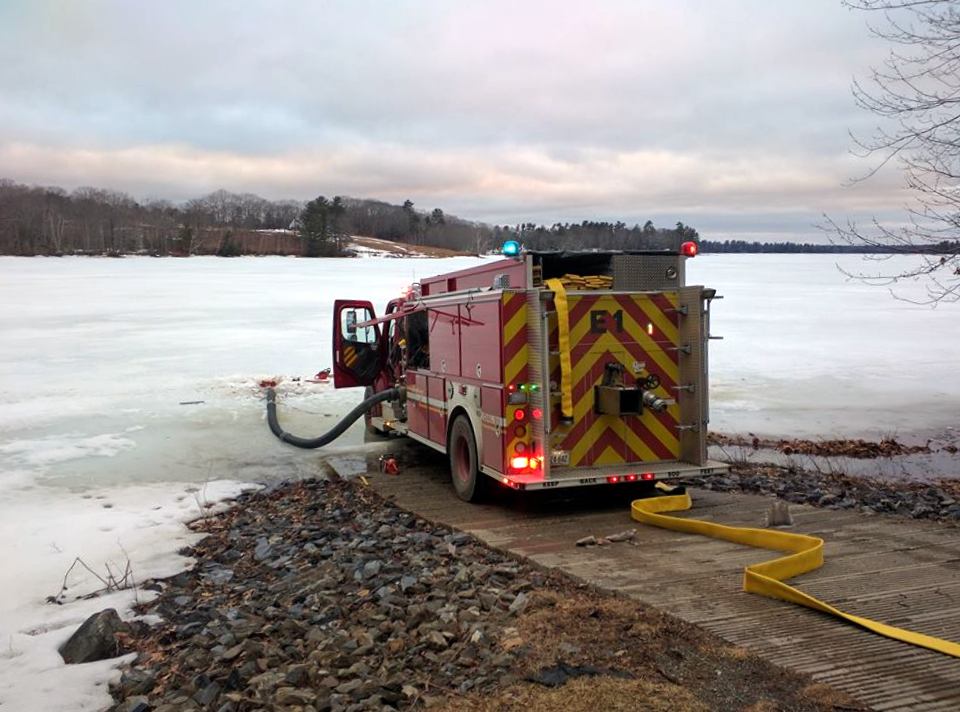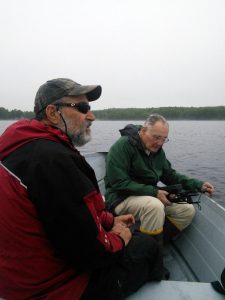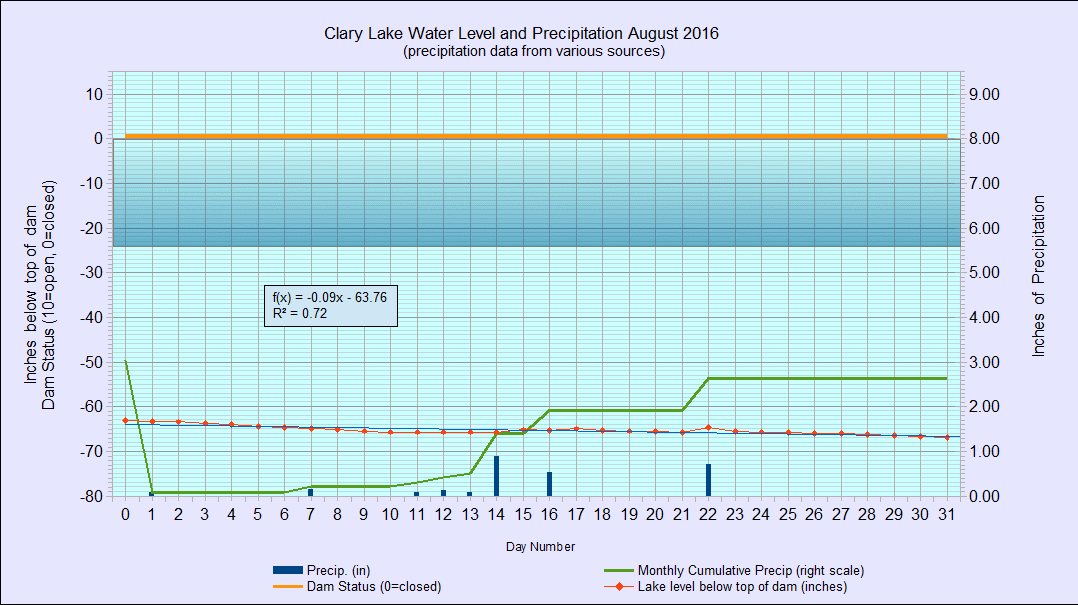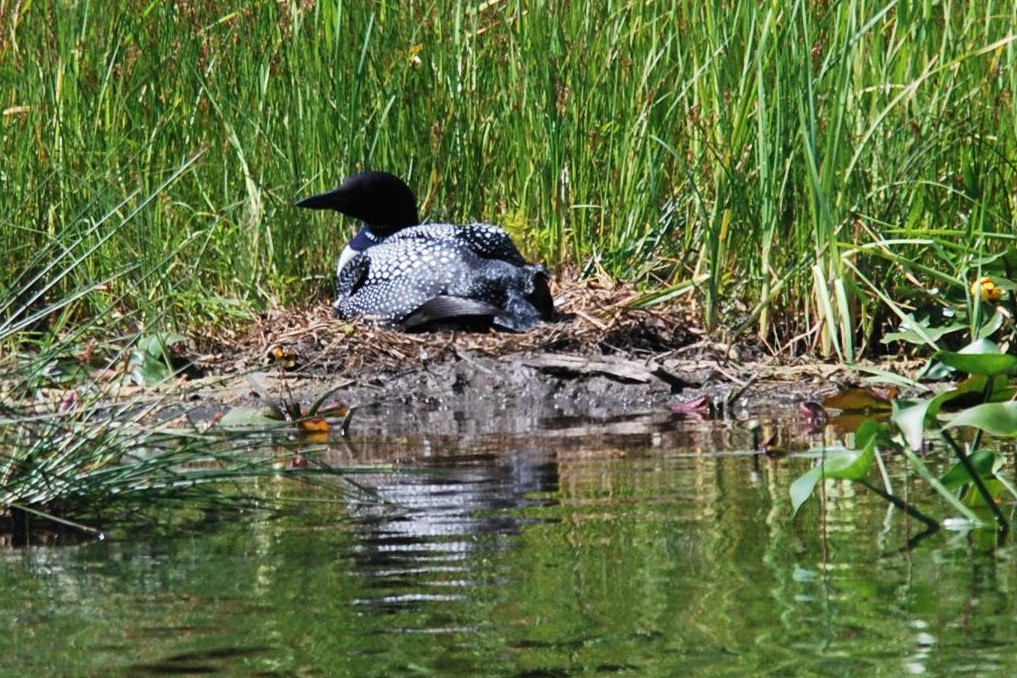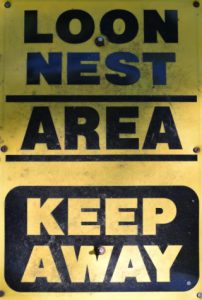 We just received 5.15″ of rain in a little over 2 days which, had we not been suffering under drought conditions, would have brought the lake up close to two feet or more. However because so much of the rainfall ended up soaking into the ground and not running off into the lake, the water level has only come up 7.44″ yielding a pathetic runoff multiplier of about 1.4X. Now that the ground is pretty much saturated, we should get more bang for the buck from the next rain storm due in this coming Sunday and Monday.
We just received 5.15″ of rain in a little over 2 days which, had we not been suffering under drought conditions, would have brought the lake up close to two feet or more. However because so much of the rainfall ended up soaking into the ground and not running off into the lake, the water level has only come up 7.44″ yielding a pathetic runoff multiplier of about 1.4X. Now that the ground is pretty much saturated, we should get more bang for the buck from the next rain storm due in this coming Sunday and Monday.
Category Archives: Lake Environment
31 August 2017 Maine Things Considered: The Water Level On This Maine Lake Has Plummeted
The story on Clary Lake by Maine Public Radio’s Susan Sharon aired on “Maine Things Considered” late this afternoon. If you missed it, not to worry: a transcript with audio and pictures has been posted on the Maine Public Radio website and Facebook Page:
25 June 2017: Nesting Loon Update
I’ve been meaning to post an update on our nesting loons for more than a week, but I’ve been a little busy! As of this morning there was a loon sitting on the nest. I first spotted the nest 19 days ago, on June 6th but it is likely that nesting had been underway for about a week earlier. This would make the eggs 25-26 days old. The gestation period for loon eggs is 28 to 30 days so with luck they’ll hatch in 3-5 days. The nest is abandoned shortly after the chicks hatch.
The lake level has fallen 10″ or more since the nest was started. The net effect of this drop in lake level has been to increase the distance between the nest and the water. If the distance to the water becomes too great, they’ll abandon the nest however it doesn’t look like that’s going to happen this time. I’ve got my fingers crossed.
The last time a loon family successfully nested on Clary Lake was in 2008.
07 June 2017: Loon Nest Spotted on Clary Lake
The Loons are once again trying to nest on Clary Lake. This year’s nest is located in more or less the traditional loon nesting location, in the cove over by the floating bog on the north shore, just east of the outlet. The loons haven’t faired too well in recent years and I truly hope they succeed this time around. The last time they successfully hatched some eggs was back in 2008. We’ve documented numerous failed nesting attempts since then, and severe variations in water level has been the primary cause of nest failure. Last year, their eggs turned out not to be fertile.
Typically the male and female loons build the nest together over the course of a about week in late May or early June and lay eggs shortly thereafter. Gestation is 28 to 30 days. Since they can only walk on land with great difficulty, they try to build their nest just a few inches above the water surface to facilitate getting on an off it. I don’t know when they started sitting on this latest nest, but it appears to be a good 8″ to 10″ above the water surface indicating the lake may have already fallen as much as 5″ or 6″ since being built. Therefore I’d guestimate they started sitting on the nest around the 1st of June, give or take a few days. With a lot of luck, we might see babies somewhere around the end of June. This however depends on the lake level staying relatively stable for the rest of this month. It is currently falling about 3/4″ per day, and it won’t take long to strand the nest at that rate.
The lake level is currently -38″ below the high water mark and falling. I challenge Mr. Kelley to shut the dam’s gate to maintain the current water level for the next month to give the nesting loons a chance to raise a family. Continue reading
18 April 2017: Spring Musings and a Look Ahead
[dropcap]I[/dropcap] try to keep this news forum factual and informative and not all that speculative. From time to time however I am compelled to offer up some commentary on what has been happening, where we are and where it looks like we are headed. This is one of those times. My goal is to bring some perspective and commonality into our lives where they intersect with Clary Lake and the travails that have assaulted it for so long. Spring is a good time for this kind of musing: it’s a time to wake up, gear up, get in shape, and get ready for another season. I feel this is going to be an important year, that a lot is going to happen. We may not see a resolution of our water level crisis this year but then again we might, the problem being that I really have no idea what a “resolution” might look like. Certainly we’ll see some real progress towards a resolution. Not only am I prepared to be surprised, I expect to be. If one thing has been proven time and time again it is that we have no idea what lies around the next corner. Continue reading

[UPDATED] Clary Lake Ice Out Video April 13, 2017
Here’s a video of Clary Lake ice out on April 13, 2017 made from images from Clarycam 2 and Clarycam 3. Technically the ice isn’t fully out yet, but for me from where I’m sitting it’s ALL GONE. As of this morning however, there was still quite a bit of very gray looking ice in the east end of the lake almost to the State boat launch. I fully expect it will be out before the end of the day now that the sun is getting up and the wind is picking up.
I would have included a segment from Clarycam 2 sitting down on David Hodsdon’s shore line, but it has stopped working. Too soon to say whether or when we’ll replace it, or with what. I’m actually a little disillusioned with these Foscam cameras: remote access to them is tedious, the proprietary software used to access and manage them is one step above garbage, and the browser plugin to view realtime video is no longer supported by any reputable web browser. I have only got it working by installing an Extended Support Release of Firefox. Unacceptable.
[UPDATE]: David Hodsdon has informed me that his camera is truly dead. He thinks is it still under warranty and is going to see about getting it repaired/replaced.
Incidentally, David sent me the image that I’m using as a header image on this post. He spent some time the other day waiting for just the right conditions to take the picture.
Clary Lake: A Year In Pictures
A little over a year ago I got this idea of assembling a year’s worth of webcam pictures into a video. Our webcams take a picture every two minutes from 4:00 AM until 10:00 PM and upload them to the server, so I simply modified the script that manages the webcam photos so as to archive all pictures taken at the top of the hour (i.e., 4:00, 5:00, 6:00, etc) in a separate directory for safe keeping. Then I forgot about it. Then a couple of days ago, I remembered it!
So here is the video. It covers 365 days from March 9, 2016 through March 9, 2017. There are a few days missing (including 3-13-16 through 3-15-16 which coincided with ice out last spring for some reason, and a couple of other days in the fall). I also decided to delete all the night-time photos, ending up with 4,651 pictures covering Clary Lake in all its glory, compiled into a video at a frame rate of 10/second. It is 7:45 long. Best viewed full screen with the sound on:
26 October 2016: Updated Transparency & Phosphorus Charts Posted
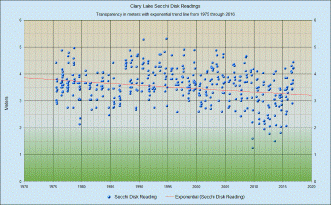 Every fall after the water quality monitoring activities end for the year (see “2016 Water Quality Monitoring Season Concludes“) I make a point of updating the Transparency and Total Phosphorus charts for Clary Lake, posting them on the website, and writing about them. I also share them with the Maine VLMP and the Maine DEP. These graphs now depict 41 years worth of data collected by certified water quality monitors from 1975 through the end of the just-ended 2016 season. Both graphs continue to show alarming trends, toward higher phosphorus levels and lower secchi disk readings. These trends are familiar to us, and go hand in hand: phosphorus feeds algae whose rapid growth reduces transparency. When transparency drops below 2 meters, you’ve got a bloom. As phosphorus levels trend up, transparency trends down. The trend lines of both graphs are clearly influenced by data from the last 10 years, and in particular, from the last 5. And we all know what’s been happening to Clary Lake over the last 5 years.
Every fall after the water quality monitoring activities end for the year (see “2016 Water Quality Monitoring Season Concludes“) I make a point of updating the Transparency and Total Phosphorus charts for Clary Lake, posting them on the website, and writing about them. I also share them with the Maine VLMP and the Maine DEP. These graphs now depict 41 years worth of data collected by certified water quality monitors from 1975 through the end of the just-ended 2016 season. Both graphs continue to show alarming trends, toward higher phosphorus levels and lower secchi disk readings. These trends are familiar to us, and go hand in hand: phosphorus feeds algae whose rapid growth reduces transparency. When transparency drops below 2 meters, you’ve got a bloom. As phosphorus levels trend up, transparency trends down. The trend lines of both graphs are clearly influenced by data from the last 10 years, and in particular, from the last 5. And we all know what’s been happening to Clary Lake over the last 5 years.
As mentioned, secchi disk readings below 2 meters (6.6′) signify an algae bloom in progress. As you can see from the above chart, prior to 2009 we didn’t record any secchi disk readings below 2 meters. In 2009 we experienced a severe algae bloom- Clary’s first- with secchi disk readings of 1.60m on 8/28/09 and 1.25m on 9/11/09. I don’t have any record of lake levels for that summer, but it was an exceedingly wet summer season with 22.9″ of rain recorded in Augusta for the 4 month period May, June, July, and August. That’s over half the average yearly rainfall, received in just 4 months. This would have resulted in significant runoff and undoubtedly played a major role in the algae bloom that summer. Continue reading
2016 Water Quality Monitoring Season Concludes
David Hodsdon and I concluded our water quality monitoring on Clary Lake for 2016 with our last data collection session this past Sunday morning. It was cold and windy. Roughly every 2 weeks since we started on May 20th, rain or shine, David and I (and Jack Holland when he could make it) have ventured out to the “deep hole” in my boat to collect water quality data including water transparency (secchi disk readings) and dissolved oxygen/temperature measurements. Three to four times a year we take a core sample of water for Phosphorus analysis. This information is periodically submitted to the Maine Volunteer Lake Monitor Program (VLMP) for review and analysis. We usually start collecting data in mid to late April, and my boat was ready to go this spring but our YSI Pro 20 Dissolved Oxygen Meter was in the shop for repairs and we didn’t get it back until mid May. Maine Volunteer Lake Monitor Program of which the Clary Lake Association is a longtime member wants water monitoring data collected during the boating season which is generally understood to extend from May through September. This year we collected data on 13 separate occasions. Continue reading
August 2016 Water Level Chart Archived
I’ve archived the August 2016 Water Level Chart (at left). The most notable feature of the August chart is that it looks identical to the July 2016 chart except the water level is lower. The month started with the lake level at 63.24″ below the top of the dam and after a slow but steady decline of about 0.12″ per day, ended the month at a historic low level of -66.84″.
Rainfall for the month at 2.64″ was about 2/3 of an inch below normal. For the year to date we’re about 2.3″ below normal, not as bad as other parts of the state but still drought conditions.
Not much else to say about the August water level chart. You’ve only seen Clary Lake this low once before, 11 months ago on September 29, 2015.
28 August 2016: State Boat Launch Rock Cleanup Initiative Finished
We had a great turn out for the Boat Launch Rock Cleanup event yesterday with 30 people showing up to move rocks or assist in other ways. A few people unable to move rocks fulfilled other important roles. Everyone contributed in one way or another. The rock moving itself, which was expected to take the better part of 4 hours, was pretty much finished before lunch, in about an hour and a half.
The folks in the group-photo are left to right, front row kneeling: Lucy Norman, Erin Grimshaw and her 3 sons Corey Dey Bishop, Jayden Dey Bishop, and Devon Dey Bishop, Colin Fergusson; Second row: Don Norman, Melissa Palmer-Karas, Alicia Fraser, Mary Gingrow-Shaw, Margaret Fergusson, George Fergusson (not smiling for some reason) Karen Nielsen and Sara Roy; Third row: Dee Ann Grazioso, Barbara Ahern, Bill Donovan, Osmand Karas, Nathan Williams, John Williams, Tom Vigue, Jeff French; Fourth row: Tim Harkins, David Knight, Jack Holland, Randy Wing. Not pictured are Ellis Percy and John Ahern who weren’t involved in the rock moving, and Thomas Gillette and Bruce MacDonald who showed up later when the work was finished.
The work got done, we had a blast, nobody got hurt, and nobody freaked out when a good sized water snake crawled out of the shrinking rock pile and swam off between people’s legs. I caught a brief glimpse of it but wasn’t quick enough with my camera to get a picture of it. Continue reading
State Boat Launch Cleanup Update: Saturday 27 August
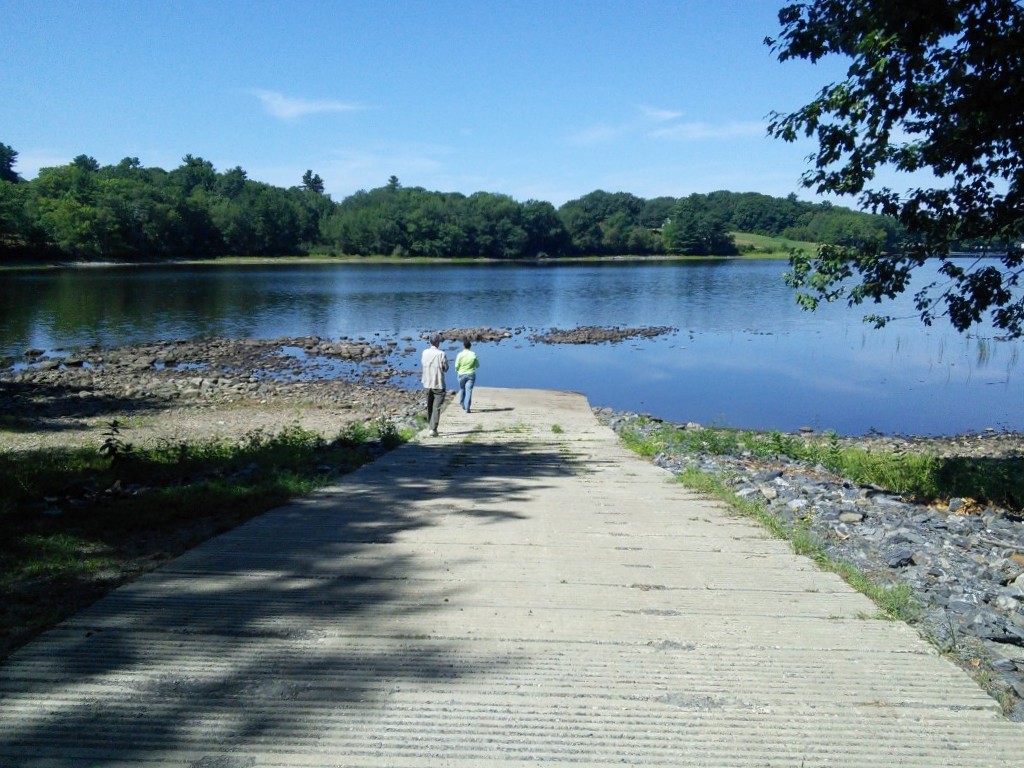 We’re all set to go tomorrow morning to move rocks at the State boat launch. A good crowd of people have indicated they plan to come by to either help move rocks, or kibitz. In any case, all are welcome: it promises to be a fun time and the weather is looking to be about perfect.
We’re all set to go tomorrow morning to move rocks at the State boat launch. A good crowd of people have indicated they plan to come by to either help move rocks, or kibitz. In any case, all are welcome: it promises to be a fun time and the weather is looking to be about perfect.
The Momentum Committee will be showing up about 9 AM to get things set up with the work set to start about 10 AM. Hopefully we’ll be able to wrap up around 2 PM or shortly thereafter. Lunch will be served mid-way through the day. We’re providing hamburgers, hotdogs, potato chips, water, etc.
The water level hit -66″ below the top of the dam this morning (a little lower than the picture shows above, which was taken last summer) so it really is about as low as it can get. However, there’s still a good 6″ to 12″ of water where we’ll be working, so plan your wardrobe accordingly: rubber boots or sneakers are in order along with shorts and work gloves. Remember we’ll be handling wet slippery rocks so sandals or barefeet are NOT recommended. The bottom is generally pretty hard however, so you don’t have to worry about getting stuck in the mud!
Any last minute questions, feel free to call George Fergusson. Hope to see you there!
Clary Lake Association To Clear Rocks at State Boat Launch Saturday August 27th
 The Clary Lake Association has received authorization from the Maine Department of Inland Fisheries & Wildlife (IF&W) to clear some rocks away from the end of the State boat launch. These rocks constitute a boating hazard which over the years since the boat launch was built have claimed more than a few outboard props and lower units. After discussing this project with representatives of the IF&W, the Clary Lake Association requested IF&W file for a Permit By Rule with the Maine Department of Environmental Protection under the National Resource Protection Act’s Permit By Rule Standards. They did just that, and we received the go-ahead to do the work earlier this week.
The Clary Lake Association has received authorization from the Maine Department of Inland Fisheries & Wildlife (IF&W) to clear some rocks away from the end of the State boat launch. These rocks constitute a boating hazard which over the years since the boat launch was built have claimed more than a few outboard props and lower units. After discussing this project with representatives of the IF&W, the Clary Lake Association requested IF&W file for a Permit By Rule with the Maine Department of Environmental Protection under the National Resource Protection Act’s Permit By Rule Standards. They did just that, and we received the go-ahead to do the work earlier this week.
The applicable rule is Chapter 305 Section 6 “Movement of Rocks & Vegetation” which provides for limited clearing of rocks and vegetation by hand from a 10′ wide area. Other requirements of the work to be done are that the rocks cannot be removed from the lake gut must be redistributed into small piles that fish fry can use to take refuge, rather than just randomly scattering them. Since this exercise is to remove a boating hazard, the rocks obviously shouldn’t be piled up in a fashion or location that will have them interfering with boat traffic in the future.
Obviously, this work needs to be done while the water level is low. Once the fall rains start and the lake level starts to rise, it will be too late. The water level is currently a little over 65″ below the top of the dam, about 2″ lower than in the photograph above which was taken last summer in July. To that end we have tentatively scheduled a work session (I prefer to call it a party) from 10:00 AM to 2:00 PM on Saturday August 27th to do the rock clearing and we’ll be looking for volunteers to help with the project. Many hands will make the work go quickly! In the next day or so we’re going to send an email mailing to Clary Lake Association members to drum up interest in helping with this project. There are a number of ways you can help with this project. If you’re interested in participating in the actual rock moving or just want to come by, enjoy the event, have fun, and support us in this endeavor, please contact George Fergusson or give me a call at 207-549-5991.
Since we’re going to be splashing around in 6″ to 12″ of water, we’ll be doing this work rain or shine unless there’s an absolute deluge that day in which case we’ll put the work off until the next day. People interested in helping should wear rubber boots or sneakers because you’ll be getting wet. We also recommend gloves. We’ll have a few crowbars available for those recalcitrant stuck-in-the-mud rocks.
There’ll be a cookout around lunch time, and contributions toward this are welcome. It promises to be a fun event. We look forward to your participation!
18 July 2016: Alarming Growth of Elodea Observed in Clary Lake
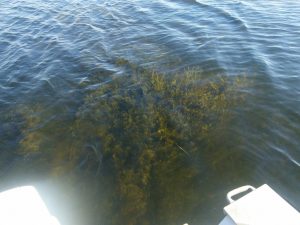
Elodea nuttallii in Clary Lake growing to the surface in 7′ of water. Photograph by George Fergusson 15 July 2016
Just when you thought conditions around Clary Lake couldn’t get any worse, well conditions got worse: anyone who has spent any time on Clary Lake this summer is all too aware of the explosive growth of Elodea in shallow areas around the lake. Rapid growth of this pond weed was a noticeable problem last summer and it has only gotten worse, not better. Elodea nuttallii is not a recognized invasive plant species in Maine but it is considered invasive in some jurisdictions including in Europe where it is a real problem. It’s an opportunistic plan in any case, and under the right conditions it can be very prolific. Clearly the conditions existing in Clary Lake now are about perfect to promote exuberant growth of this plant: lots of shallow water with a muddy bottom, plenty of nutrients, and lots of sun. Elodea growth has gotten so bad in some places that there are large mats of the weed on or just under the surface of the water, even near the middle of the lake. I took the above picture about 1400′ off the south shore of the lake- almost 1/3 of the way across to the other side- in 7′ of water. Normally the water would be 12 feet deep here, too deep to support the growth of Elodea. Now, with the lake level down 5 feet below the top of the dam, conditions are perfect. Everywhere you go it seems you’re seeing Elodea at or just below the surface. You’ll find more pictures in the Spring/Summer 2016 photo gallery. Continue reading
28 June 2016: Yet Another Loon Video
This summer’s loon nesting episode on Clary Lake has provided unparalleled photographic and video opportunities. Yesterday I posted a video of one of the loons climbing onto their nest. This new video is comprised of 3 short video clips stitched together that I took back on June 23rd and 24th and shows a loon sitting on the nest. Who knew watching a loon breath could be so exciting 🙂
This video taken with a Nikon D3300 DSLR camera attached to the prime focus of a 6″ f/5 Newtonian reflector with 2X Barlow (doubler) which amounts to a telephoto lens with an effective focal length of 1524 mm. The nest was located approximately 380′ away from the camera.
27 June 2016: Video of Loon Climbing Onto Nest
I’ve wanted to capture video of a loon climbing onto its nest ever since the first time I saw one do it. Loons are clearly not built for getting around on dry land, but they manage. I’ve tried two other times to capture this event but circumstances conspired to thwart my efforts. I got some nice video (will post some at a later time) but catching this special event has eluded me. Until today. It was windy which caused the camera to bounce around, but the wind let up briefly at just the right time. The video ended when the battery in my camera died. Enjoy.
I’ve been able to set my camera, telescope, and tripod up in a spot in some bushes a good distance away from the nest where I could observe the loons almost without being seen. As you can see from the video, the loon was clearly unconcerned by my presence, though it certainly knew I was there.
26 June 2016: Loon Nest Update, More Pictures
Arlene Wing has sent me some great pictures of the nesting loons and I’ve added them to the 2016 Loon Nest Gallery. She and her husband Randy own the former Crow property, that beautiful place located next to the State boat launch. Their house overlooks the cove where the loons are nesting this summer. She and Randy can actually watch the nest from the comfort of their home. I stopped over there this morning for coffee and a visit, and they’ve got a spotting scope set up in the den. How cool is that! Continue reading
22 June 2016: Loon Nest Update, New Pictures Added to Site
[dropcap]The[/dropcap] nesting Loons are doing fine and it appears that people are respecting the bird’s need for privacy and not venturing inside the LOON AREA signs. I stopped by today to try out my hastily-fabricated telephoto lens arrangement and took some pictures of the loons that came out rather well I think. Though it looks like I was right on top of them, I wasn’t. Not even close. From where I was set up on the lawn looking down on the nest, my range finder said I was about 390′ away from the nest. The loons barely took notice of me. The pictures were taken with a 6″ f/5 Newtonian reflector telescope which I normally use for observing stars, planets, comets, and nebulae. I hooked my digital Nikon D3300 camera up to it which gave me what amounted to a 762 mm focal length telephoto lens. By adding a 2x barlow lens I was able to double that to effectively a 1524 mm focal length telephoto lens. Continue reading
18 June 2016: Loon Nest Update
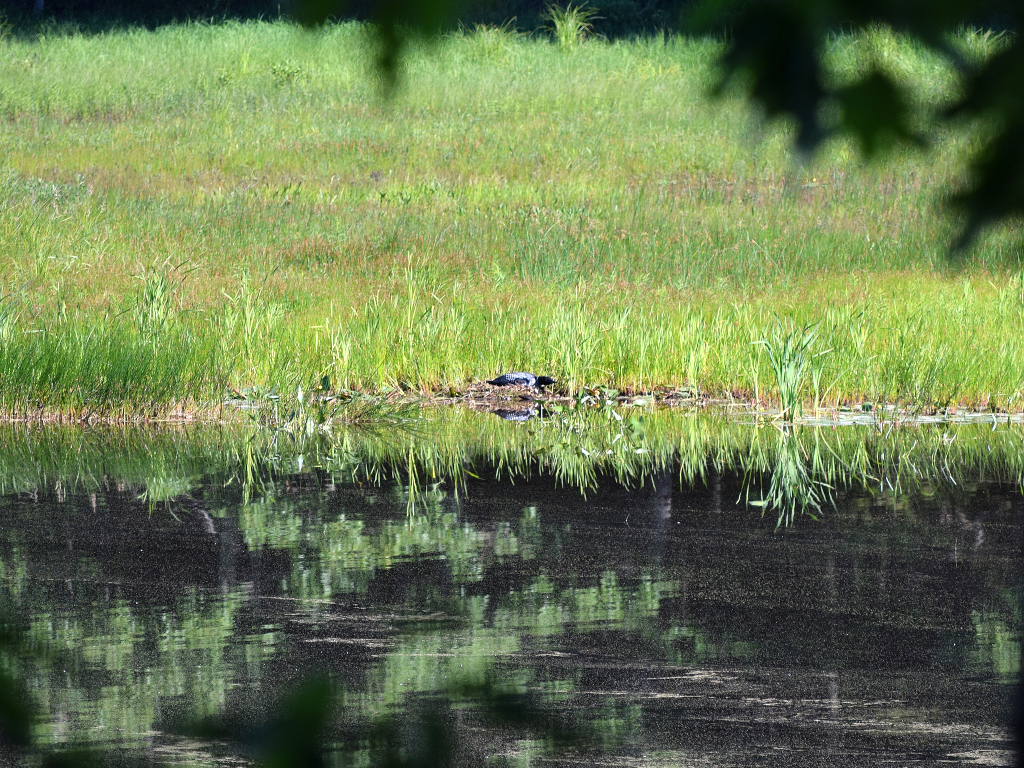
A loon sitting on the nest, trying to maintain a low profile. I took the picture from Randy & Arlene Wing’s shoreline. Their place is admirably suited for observing the nest without disturbing the loons. The water level at the time this picture was taken was a little over 56″ below the top of the dam. Photograph by George Fergusson 18 June 2016
17 June 2016: Loon Nest Spotted on Clary Lake!
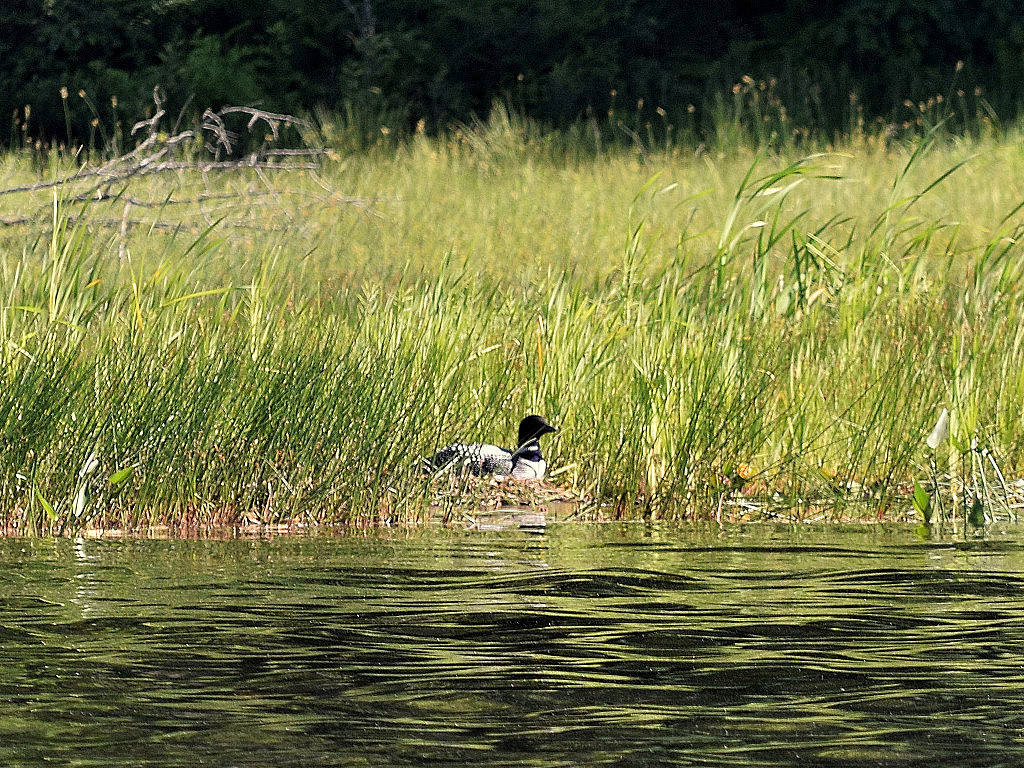 For the first time since the summer of 2012, a pair of loons is attempting to nest again on Clary Lake. This is fantastic news and it has us very excited. The nest is located at the end of the sandbar on the east end of the lake 800′ to 900′ feet northwest of the State Boat launch, opposite Randy and Arlene Wing’s home which is the white cape located next to the boat launch. In fact news of the loon nest was brought to my attention by Arlene Wing who sent me an email last night. David Hodsdon, Jack Holland, and I were scheduled to conduct our biweekly water quality monitoring data-collection exercise this morning and after we were done we boated over and confirmed that there is indeed a loon nest there. I was able to get a couple of pictures of the sitting loon without getting too close.
For the first time since the summer of 2012, a pair of loons is attempting to nest again on Clary Lake. This is fantastic news and it has us very excited. The nest is located at the end of the sandbar on the east end of the lake 800′ to 900′ feet northwest of the State Boat launch, opposite Randy and Arlene Wing’s home which is the white cape located next to the boat launch. In fact news of the loon nest was brought to my attention by Arlene Wing who sent me an email last night. David Hodsdon, Jack Holland, and I were scheduled to conduct our biweekly water quality monitoring data-collection exercise this morning and after we were done we boated over and confirmed that there is indeed a loon nest there. I was able to get a couple of pictures of the sitting loon without getting too close.
 Our resident Loon expert Mary Gingrow-Shaw (pictured at left) helped me round up the Association’s floating “LOON NEST AREA” signs which have been languishing in the weeds near my boat launch and together we headed over about noon today and set 3 of them just off shore from the sandbar to warn boaters away from the nest. Hopefully people will see these signs and give the loons the peace and solitude they require. People however are the least of the problems these marvelous bird face. They are vulnerable to attack by eagles from the air and coyotes and foxes from the shore. Once the eggs hatch (gestation period is 26 to 31 days) the risks only increase: I’ve seen more than a few baby loons snatched by snapping turtles than I care to remember.
Our resident Loon expert Mary Gingrow-Shaw (pictured at left) helped me round up the Association’s floating “LOON NEST AREA” signs which have been languishing in the weeds near my boat launch and together we headed over about noon today and set 3 of them just off shore from the sandbar to warn boaters away from the nest. Hopefully people will see these signs and give the loons the peace and solitude they require. People however are the least of the problems these marvelous bird face. They are vulnerable to attack by eagles from the air and coyotes and foxes from the shore. Once the eggs hatch (gestation period is 26 to 31 days) the risks only increase: I’ve seen more than a few baby loons snatched by snapping turtles than I care to remember.
By far the biggest threat these nesting loons now face is from fluctuating water levels. Their nest can either become stranded if the lake level falls too much, or get flooded if it rises too much. As you can see in the picture, loon nests don’t have a lot of freeboard- only 3″ or 4″ at most. An inch or 2 of rain is all it will take to bring the lake up that much and more.
These floating signs were built many years ago by long time Clary Lake Association member Edward Grant and were last used in 2012 when a loon pair attempted to nest in the marsh over on the west end of the lake by Route 126. Sadly, that nesting attempt failed when the nest was flooded. Let’s hope that doesn’t happen again. Please everyone, respect these signs and give the Loon nest a wide berth. We’ll be monitoring the nest from the shoreline and will post more pictures and updates as the summer progresses.

